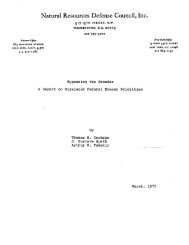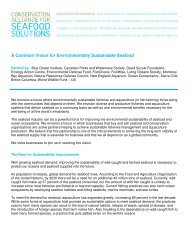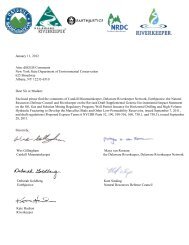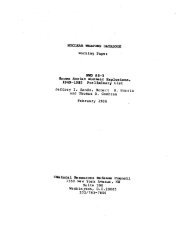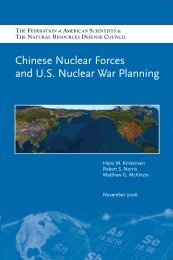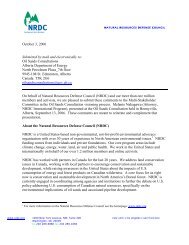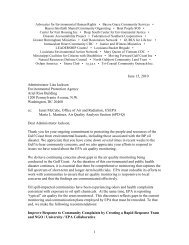NRDC: Executive Summary, Chinese Nuclear Forces and U.S. ...
NRDC: Executive Summary, Chinese Nuclear Forces and U.S. ...
NRDC: Executive Summary, Chinese Nuclear Forces and U.S. ...
Create successful ePaper yourself
Turn your PDF publications into a flip-book with our unique Google optimized e-Paper software.
THE FEDERATION of AMERICAN SCIENTISTS &<br />
THE NATURAL RESOURCES DEFENSE COUNCIL<br />
<strong>Chinese</strong> <strong>Nuclear</strong> <strong>Forces</strong><br />
<strong>and</strong> U.S. <strong>Nuclear</strong> War Planning<br />
Dedicated to Sally Lilienthal<br />
Hans M. Kristensen<br />
Robert S. Norris<br />
Matthew G. McKinzie<br />
November 2006
ABOUT THE AUTHORS<br />
Hans M. Kristensen is Director of the <strong>Nuclear</strong> Information Project at the Federation<br />
of American Scientists. He is co-author of the <strong>Nuclear</strong> Notebook column in the Bulletin<br />
of the Atomic Scientists <strong>and</strong> the World <strong>Nuclear</strong> <strong>Forces</strong> overview in the SIPRI<br />
Yearbook. His research focuses on the evolution of nuclear strategy <strong>and</strong> operations<br />
in the post-Cold War era, <strong>and</strong> his disclosure of preemptive nuclear strike options in<br />
the revised Doctrine for Joint <strong>Nuclear</strong> Operations in 2005 caused the Pentagon to<br />
cancel the document (see: http://www.nukestrat.com/us/jcs/canceled.htm). Contact:<br />
hkristensen@fas.org, (202) 454-4695.<br />
Robert S. Norris is a senior research associate with the <strong>NRDC</strong> nuclear program <strong>and</strong><br />
director of the <strong>Nuclear</strong> Weapons Databook project. He is co-editor of the <strong>Nuclear</strong><br />
Weapons Databook series, the five-volume definitive encyclopedia of the nuclear<br />
weapons of the United States, Soviet Union/Russia, Britain, France <strong>and</strong> China. He<br />
is also the author of Racing for the Bomb (2002), a biography of General Leslie R.<br />
Groves, the head of the Manhattan Project, which built the atomic bomb during<br />
World War II. Contact: rnorris@nrdc.org, (202) 289-2369.<br />
Matthew G. McKinzie is currently a scientific consultant to the <strong>Nuclear</strong> Program at the<br />
Natural Resources Defense Council. Since obtaining his Ph.D. in experimental nuclear<br />
physics, he has worked in the areas of nuclear non-proliferation, the environmental<br />
impacts of nuclear weapons production, homel<strong>and</strong> security <strong>and</strong> the application of<br />
satellite imagery <strong>and</strong> Geographic Information Systems (GIS) to human rights.<br />
Contact: mmckinzie@nrdc.org, (202) 299-4393 (cell).<br />
© Federation of American Scientists/Natural Resources Defense Council, November 2006<br />
Federation of American Scientists<br />
1717 K. Street, NW, Suite 209<br />
Washington, D.C. 20036<br />
Phone: 202-454-3300<br />
Fax: 202-675-1010<br />
Web: www.fas.org<br />
Natural Resources Defense Council<br />
1200 New York Avenue, NW, Suite 400<br />
Washington, D.C. 20005<br />
Phone: 202-289-6868<br />
Fax: 202-289-1060<br />
Web: www.nrdc.org<br />
This report <strong>and</strong> supporting material are available on the Internet from the following links:<br />
FAS: http://www.nukestrat.com/china/chinareport.htm<br />
<strong>NRDC</strong>: http://www.nrdc.org/nuclear/default.asp<br />
ISBN: 0-9653386-451500
TABLE OF CONTENTS<br />
About the Authors . . . . . . . . . . . . . . . . . . . . . . . . . . . . . . . . . . . . . . . . . . . . .ii<br />
Table of Contents . . . . . . . . . . . . . . . . . . . . . . . . . . . . . . . . . . . . . . . . . . . . . .iii<br />
List of Figures . . . . . . . . . . . . . . . . . . . . . . . . . . . . . . . . . . . . . . . . . . . . . . . . .v<br />
List of Tables . . . . . . . . . . . . . . . . . . . . . . . . . . . . . . . . . . . . . . . . . . . . . . . .viii<br />
Abbreviations . . . . . . . . . . . . . . . . . . . . . . . . . . . . . . . . . . . . . . . . . . . . . . . . .ix<br />
Acknowledgements . . . . . . . . . . . . . . . . . . . . . . . . . . . . . . . . . . . . . . . . . . . . .x<br />
<strong>Executive</strong> <strong>Summary</strong> . . . . . . . . . . . . . . . . . . . . . . . . . . . . . . . . . . . . . . . . . . . . .1<br />
The United States Has Overpowering Superiority . . . . . . . . . . . . . . . . . . . . . . . .2<br />
China’s No-First-Use Policy . . . . . . . . . . . . . . . . . . . . . . . . . . . . . . . . . . . . . . . . . .4<br />
A Rationale for Spending <strong>and</strong> Operations . . . . . . . . . . . . . . . . . . . . . . . . . . . . . .7<br />
The Consequences of a <strong>Nuclear</strong> Strike . . . . . . . . . . . . . . . . . . . . . . . . . . . . . . . .10<br />
Conclusions <strong>and</strong> Recommendations: We Don’t Need Another Cold War . . . .12<br />
I. The Debate over China’s <strong>Nuclear</strong> Modernization . . . . . . . . . . . . . . . . . . . .15<br />
The Office of the Secretary of Defense . . . . . . . . . . . . . . . . . . . . . . . . . . . . . . . .18<br />
Estimates From the Intelligence Community . . . . . . . . . . . . . . . . . . . . . . . . . . .21<br />
Congress <strong>and</strong> the 1999 Cox Report . . . . . . . . . . . . . . . . . . . . . . . . . . . . . . . . . . .23<br />
Congressional Research Service . . . . . . . . . . . . . . . . . . . . . . . . . . . . . . . . . . . . . .28<br />
China’s <strong>Nuclear</strong> Weapons Policy . . . . . . . . . . . . . . . . . . . . . . . . . . . . . . . . . . . . .30<br />
II. Estimates of <strong>Chinese</strong> <strong>Nuclear</strong> <strong>Forces</strong> . . . . . . . . . . . . . . . . . . . . . . . . . . . .35<br />
<strong>Nuclear</strong> Ballistic Missiles . . . . . . . . . . . . . . . . . . . . . . . . . . . . . . . . . . . . . . . . . . .46<br />
The Issue of Mobility . . . . . . . . . . . . . . . . . . . . . . . . . . . . . . . . . . . . . . . . . . . .47<br />
The Issue of Multiple Warhead Payloads . . . . . . . . . . . . . . . . . . . . . . . . . . . .53<br />
The Issue of Missile Ranges . . . . . . . . . . . . . . . . . . . . . . . . . . . . . . . . . . . . . . .56<br />
L<strong>and</strong>-based Ballistic Missiles . . . . . . . . . . . . . . . . . . . . . . . . . . . . . . . . . . . . . .59<br />
Medium-Range Ballistic Missiles . . . . . . . . . . . . . . . . . . . . . . . . . . . . . . . . . . .61<br />
DF-3A (CSS-2) MRBM . . . . . . . . . . . . . . . . . . . . . . . . . . . . . . . . . . . . . . .61<br />
DF-21 (CSS-5) MRBM . . . . . . . . . . . . . . . . . . . . . . . . . . . . . . . . . . . . . . . .64<br />
Long-Range Ballistic Missiles . . . . . . . . . . . . . . . . . . . . . . . . . . . . . . . . . . . . .67<br />
DF-4 (CSS-3) LRBM . . . . . . . . . . . . . . . . . . . . . . . . . . . . . . . . . . . . . . . . .67
iv | Federation of American Scientists/Natural Resources Defense Council<br />
Intercontinental Ballistic Missiles . . . . . . . . . . . . . . . . . . . . . . . . . . . . . . . . . .71<br />
DF-5A (CSS-4 Mod 2) ICBM . . . . . . . . . . . . . . . . . . . . . . . . . . . . . . . . . .71<br />
DF-31 (CSS-X-10) ICBM . . . . . . . . . . . . . . . . . . . . . . . . . . . . . . . . . . . . . .73<br />
DF-31A ICBM . . . . . . . . . . . . . . . . . . . . . . . . . . . . . . . . . . . . . . . . . . . . . . .75<br />
Other <strong>Nuclear</strong> Ballistic Missiles . . . . . . . . . . . . . . . . . . . . . . . . . . . . . . . . . . .76<br />
The <strong>Chinese</strong> Submarine Force . . . . . . . . . . . . . . . . . . . . . . . . . . . . . . . . . . . . . . .77<br />
<strong>Nuclear</strong>-Powered Ballistic Missile Submarines . . . . . . . . . . . . . . . . . . . . . . . .79<br />
<strong>Nuclear</strong>-Powered Attack Submarines . . . . . . . . . . . . . . . . . . . . . . . . . . . . . . .86<br />
Submarine Operations . . . . . . . . . . . . . . . . . . . . . . . . . . . . . . . . . . . . . . . . . . .87<br />
Medium-Range Bombers . . . . . . . . . . . . . . . . . . . . . . . . . . . . . . . . . . . . . . . . . . .93<br />
Tactical <strong>Nuclear</strong> Weapons . . . . . . . . . . . . . . . . . . . . . . . . . . . . . . . . . . . . . . . . . .98<br />
<strong>Nuclear</strong> Cruise Missiles . . . . . . . . . . . . . . . . . . . . . . . . . . . . . . . . . . . . . . . . . . .104<br />
Ballistic Missile Test Launch Facilities . . . . . . . . . . . . . . . . . . . . . . . . . . . . . . .106<br />
Underground Facilities . . . . . . . . . . . . . . . . . . . . . . . . . . . . . . . . . . . . . . . . . . . .110<br />
<strong>Nuclear</strong> Weapons Testing . . . . . . . . . . . . . . . . . . . . . . . . . . . . . . . . . . . . . . . . . .123<br />
III. China in U.S. <strong>Nuclear</strong> War Planning . . . . . . . . . . . . . . . . . . . . . . . . . .127<br />
The Role of Non-Strategic <strong>Nuclear</strong> Weapons . . . . . . . . . . . . . . . . . . . . . . . . . .133<br />
Sea-Launched Ballistic Missile Submarines . . . . . . . . . . . . . . . . . . . . . . . . . . . .135<br />
SSBN Comm<strong>and</strong> <strong>and</strong> Control . . . . . . . . . . . . . . . . . . . . . . . . . . . . . . . . . . . .137<br />
“Layer Upon Layer of Options” . . . . . . . . . . . . . . . . . . . . . . . . . . . . . . . . . . .141<br />
A New Deterrent in the Pacific . . . . . . . . . . . . . . . . . . . . . . . . . . . . . . . . . . . . .148<br />
The Denuclearization of South Korea . . . . . . . . . . . . . . . . . . . . . . . . . . . . . . . .157<br />
China Back in the Crosshairs . . . . . . . . . . . . . . . . . . . . . . . . . . . . . . . . . . . . . . .160<br />
The <strong>Nuclear</strong> Non-Targeting Agreement . . . . . . . . . . . . . . . . . . . . . . . . . . . . . .164<br />
Current <strong>Nuclear</strong> Planning Against China . . . . . . . . . . . . . . . . . . . . . . . . . . . . .166<br />
Recent Upgrades to Weapons <strong>and</strong> Plans . . . . . . . . . . . . . . . . . . . . . . . . . . . .170<br />
IV: Simulated U.S. <strong>and</strong> <strong>Chinese</strong> <strong>Nuclear</strong> Strikes . . . . . . . . . . . . . . . . . . . . .173<br />
Calculating the Effects of <strong>Nuclear</strong> Weapons . . . . . . . . . . . . . . . . . . . . . . . . . . .174<br />
Scenario One: U.S. <strong>Nuclear</strong> Strike Against <strong>Chinese</strong> Long-Range ICBMs . . .175<br />
Scenario Two: <strong>Chinese</strong> <strong>Nuclear</strong> Strikes Against U.S. Cities . . . . . . . . . . . . . .186<br />
Discussion of <strong>Nuclear</strong> Strike Simulations . . . . . . . . . . . . . . . . . . . . . . . . . . . . .193<br />
V: Conclusions <strong>and</strong> Recommendations . . . . . . . . . . . . . . . . . . . . . . . . . . . . .197<br />
Appendix A: <strong>Chinese</strong> <strong>Nuclear</strong> <strong>Forces</strong>, 2006 . . . . . . . . . . . . . . . . . . . . . . . .202<br />
Endnotes . . . . . . . . . . . . . . . . . . . . . . . . . . . . . . . . . . . . . . . . . . . . . . . . . . .203
LIST OF FIGURES<br />
Figure 1: Man to Man ........................................................................................15<br />
Figure 2: Wondering About <strong>Chinese</strong> Motivations............................................17<br />
Figure 3: House Armed Service Committee Witnesses on China....................28<br />
Figure 4: <strong>Chinese</strong> <strong>Nuclear</strong> Ballistic Missile Force Composition 2000-2015 ....42<br />
Figure 5: <strong>Chinese</strong> Deployed <strong>Nuclear</strong> Warhead Estimates 2000-2015...............43<br />
Figure 6: Estimated Megatonnage Of China’s <strong>Nuclear</strong> Arsenal 2006-2015 .....43<br />
Figure 7: Low Estimate For <strong>Chinese</strong> <strong>Nuclear</strong> Arsenal 2000-2015....................45<br />
Figure 8: DF-21 Missile Launcher On Narrow Road.........................................47<br />
Figure 9: Mobile Missile Communication .........................................................48<br />
Figure 10: <strong>Chinese</strong> Missiles On the Move...........................................................49<br />
Figure 11: Russian SS-25 Road-Mobile Missile Base at Novosibirsk..................52<br />
Figure 12: Speculations About <strong>Chinese</strong> Multiple Warhead Capabilities ...........55<br />
Figure 13: <strong>Chinese</strong> <strong>and</strong> U.S. Definitions for Ballistic Missile Ranges................57<br />
Figure 14: Inconsistent DOD Range Estimates For DF-5A ................................58<br />
Figure 15: DF-3A (CSS-2) Medium-Range Ballistic Missile..............................61<br />
Figure 16: DF-3A (CSS-2) Twin Launch Exercise..............................................62<br />
Figure 17: Possible Yidu DF-3 Launch Facility....................................................63<br />
Figure 18: DF-21 (CSS-5) Launchers ..................................................................64<br />
Figure 19: DF-21 (CSS-5) Missile Calibration....................................................65<br />
Figure 20: DF-21s or SAMs at Suixi Airbase ......................................................66<br />
Figure 21: DF-4 (CSS-3) Missile .........................................................................67<br />
Figure 22: Delingha DF-4 Launch Facility ..........................................................68<br />
Figure 23: Delingha DF-4 Launch Facility ..........................................................69<br />
Figure 24: Possible Delingha DF-4 Launch Facility Headquarters......................70<br />
Figure 25: DF-5A (CSS-4) Reentry Vehicle .......................................................71<br />
Figure 26: DF-5 (CSS-4) Silo Launch.................................................................72<br />
Figure 27: DF-31 (CSS-X-10) Launchers ............................................................73<br />
Figure 28: Alleged DF-31 (CSS-X-10) Warhead Section...................................74<br />
Figure 29: DF-31 Missile On Fixed Launch Pad .................................................75<br />
Figure 30: Alleged DF-41 (Ab<strong>and</strong>oned) ICBM ..................................................76
vi | Federation of American Scientists/Natural Resources Defense Council<br />
Figure 31: Alleged “New” Missile Launcher........................................................76<br />
Figure 32: U.S. Navy Projection For <strong>Chinese</strong> Submarine Force ........................77<br />
Figure 33: <strong>Chinese</strong> Submarine Force 1985-2015.................................................78<br />
Figure 34: Xia-class SSBN in Dry Dock 2005 .....................................................81<br />
Figure 35: Xia-class SSBN In Dry Dock 2005 .....................................................82<br />
Figure 36: Type 094 Class SSBN Missile Configurations....................................83<br />
Figure 37: Julang-1 SLBM....................................................................................83<br />
Figure 38: U.S. Navy Range Estimates For Julang-2 SLBM ...............................84<br />
Figure 39: Han-class (Type-091) <strong>Nuclear</strong>-Powered Attack Submarine..............86<br />
Figure 40: Shang-class (Type-093) <strong>Nuclear</strong>-Powered Attack Submarine...........87<br />
Figure 41: <strong>Chinese</strong> Maritime Reach?...................................................................88<br />
Figure 42: <strong>Chinese</strong> Submarine Patrols 1981-2005 ..............................................89<br />
Figure 43: Ming-class SS Off Japan .....................................................................92<br />
Figure 44: Han-Class SSN On Hainan Isl<strong>and</strong>? ...................................................93<br />
Figure 45: Hong-6 Intermediate-Range Bombers................................................94<br />
Figure 46: YJ-63 L<strong>and</strong>-Attack Cruise Missile......................................................95<br />
Figure 47: Anqing H-6 Bomber Airbase..............................................................96<br />
Figure 48: Xian H-6 Bomber Airbase ..................................................................97<br />
Figure 49: Wugong H-6 Bomber Airbase ............................................................98<br />
Figure 50: Qian-5 With Hydrogen Bomb?.........................................................102<br />
Figure 51: DF-15 <strong>Nuclear</strong>-Capable?...................................................................103<br />
Figure 52: <strong>Chinese</strong> Cruise Missile Under Development ...................................105<br />
Figure 53: <strong>Chinese</strong> Ground-Launched Cruise Missile.......................................106<br />
Figure 54: Wuzhai Missile <strong>and</strong> Space Test Center ............................................108<br />
Figure 55: DF-5A Test Launch Site At Jiuquan Space Launch Center............109<br />
Figure 56: Underground Submarine Facility at Jianggezhuang .........................112<br />
Figure 57: Possible Outline of Underground<br />
Submarine Facility at Jianggezhuang................................................115<br />
Figure 58: Han-Class Submarine Inside Underground Facility.........................115<br />
Figure 59: Underground Facility at Feidong Air Base.......................................116<br />
Figure 60: Urumqi Airbase With Remote Underground Facility .....................117<br />
Figure 61: President Jiang Zemin Inspects Underground Aircraft Facility.......118<br />
Figure 62: J-8 Aircraft Moved Into Underground Facility................................119<br />
Figure 63: Underground Facility at Guangzhou Shadi Air Base.......................120<br />
Figure 64: Underground Facilities at Yulin Naval Base ....................................121
Federation of American Scientists/Natural Resources Defense Council | vii<br />
Figure 65: Underground Aircraft Facility at Yangcun Airbase .........................122<br />
Figure 66: Horizontal Tunnels at Lop Nur <strong>Nuclear</strong> Test Site ...........................123<br />
Figure 67: Details of Horizontal Tunnels at Lop Nur <strong>Nuclear</strong> Test Site...........124<br />
Figure 68: Activity at Horizontal Tunnel at Lop Nur <strong>Nuclear</strong> Test Site..........125<br />
Figure 69: Pacific <strong>Nuclear</strong> Bombs 1958 .............................................................128<br />
Figure 70: Guam As <strong>Nuclear</strong> Strike Base ..........................................................130<br />
Figure 71: Kadena Air Base................................................................................134<br />
Figure 72: SSBN <strong>Nuclear</strong> Strike 1962...............................................................136<br />
Figure 73: Blue Eagle Airborne Comm<strong>and</strong> Post................................................138<br />
Figure 74: EC-130 TACAMO ...........................................................................139<br />
Figure 75: USS Ohio (SSBN-726) At Bangor, Washington ............................149<br />
Figure 76: Apra Harbor, Guam ..........................................................................155<br />
Figure 77: US SSBN Pacific Port Visits.............................................................156<br />
Figure 78: <strong>Nuclear</strong> Artillery Shells ....................................................................157<br />
Figure 79: USAF F-16 at Kunsan Air Base, South Korea.................................159<br />
Figure 80: STRATCOM: More Options Needed Against China.....................161<br />
Figure 81: U.S. Pacific SSBN Deterrent Patrols 1964-2005 .............................167<br />
Figure 82: U.S. SSBN At Sea Rates 1989-2001................................................168<br />
Figure 83: New Fuze For Enhanced W76 Warhead...........................................170<br />
Figure 84: New Modification of W76 Warhead ................................................171<br />
Figure 85: W76-1/Mk4A Accuracy Adjunct.....................................................172<br />
Figure 86: STRATCOM-Formatted <strong>Nuclear</strong> Strike File For HPAC................175<br />
Figure 87: Hypothetical U.S. SSBN Deterrent Patrol Area in Pacific.............176<br />
Figure 88: Satellite Images of U.S. <strong>and</strong> Russian ICBM Silos............................178<br />
Figure 89: Hypothetical DF-5A Silo Targets .........................................................179<br />
Figure 90: Fallout Patters For Hypothetical U.S. Strike<br />
On <strong>Chinese</strong> DF-5A Silos..................................................................183<br />
Figure 91: Casualties From U.S. Strike Against <strong>Chinese</strong> DF-5A Silos ............184<br />
Figure 92: DF-5A Ranges to U.S. Cities ...........................................................187<br />
Figure 93: <strong>Nuclear</strong> Explosive Effects of DF-5 Strikes Against New York<br />
<strong>and</strong> Los Angeles ................................................................................189<br />
Figure 94: Casualties <strong>and</strong> Fatalities From 20 DF-5A Airburst<br />
Attacks on US Cities.........................................................................190<br />
Figure 95: Fallout From Attack On 20 US Cities With 20 DF-5A 4-Mt<br />
Ground Burst Warheads.......................................................................191<br />
Figure 96: Fallout From Attack On 20 US Cities With DF-31A<br />
Ground Bursts Warheads .................................................................193
LIST OF TABLES<br />
Table 1: DIA Estimates Of <strong>Chinese</strong> <strong>Nuclear</strong> <strong>Forces</strong> (1984).................................36<br />
Table 2: China’s <strong>Nuclear</strong> Status.............................................................................37<br />
Table 3: Pentagon Overview of China’s Missile <strong>Forces</strong> 2006 ...............................38<br />
Table 4: Estimates For <strong>Chinese</strong> Warheads Primarily Targeted Against the<br />
United States in 2015 ..............................................................................40<br />
Table 5: Possible Missile Composition With DIA Projection For <strong>Chinese</strong><br />
ICBM Warheads by 2020.........................................................................41<br />
Table 6: Estimates for <strong>Chinese</strong> Megatonnage On Missiles Primarily Targeted<br />
Against the United States in 2015..........................................................44<br />
Table 7: <strong>Chinese</strong> <strong>Nuclear</strong> Ballistic Missiles 2006..................................................46<br />
Table 8: <strong>Chinese</strong> L<strong>and</strong>-Based <strong>Nuclear</strong> Ballistic Missiles 2006..............................59<br />
Table 9: Rumored <strong>Nuclear</strong> Missile Bases <strong>and</strong> Brigades .........................................60<br />
Table 10: <strong>Chinese</strong> Sea-Based <strong>Nuclear</strong> Ballistic Missiles .........................................80<br />
Table 11: DIA Projection For <strong>Chinese</strong> Non-Strategic<br />
<strong>Nuclear</strong> Weapons 1984-1995.................................................................100<br />
Table 12: Reported <strong>Chinese</strong> Ballistic Missile Tests...............................................107<br />
Table 13: SIOP Attack Options 1969 ...................................................................132<br />
Table 14: Damage From 100 Arriving Warheads (1 MT) ....................................133<br />
Table 15: “Schlesinger Doctrine” <strong>Nuclear</strong> Targeting (1974) ................................143<br />
Table 16: <strong>Chinese</strong> Targets In U.S. Selected Attack Options (1974) ...................144<br />
Table 17: U.S. SSBN Visits to South Korea..........................................................146<br />
Table 18: Effects of Radiation................................................................................182<br />
Table 19: Casualties For Variations of U.S. Hypothetical Strike Against<br />
<strong>Chinese</strong> DF-5A Silos .............................................................................185<br />
Table 20: DF-5 Warhead <strong>and</strong> Hiroshima Bomb Parameters .................................188
ABBREVIATIONS<br />
BAO................................Basic Attack Option<br />
CEP.............................Circular Error Probable<br />
CINC.............................Comm<strong>and</strong>er in Chief<br />
CINCPAC ...............................Comm<strong>and</strong>er in<br />
Chief U.S. Pacific Comm<strong>and</strong><br />
CIA ....................Central Intelligence Agency<br />
CISAC........Center for International Security<br />
<strong>and</strong> Cooperation (Stanford University)<br />
CNO......................Chief of Naval Operations<br />
CONPLAN ...........................Concept Plan or<br />
(if put into effect) Contingency Plan<br />
DEFCON...........................Defense Condition<br />
DF ...................................................Dong Feng<br />
DOD ...........................Department of Defense<br />
DOE..............................Department of Energy<br />
DIA....................Defense Intelligence Agency<br />
FOIA ..................Freedom of Information Act<br />
HF...........................................High Frequency<br />
HOB .......................................Height Of Burst<br />
HPAC..................................Hazard Prediction<br />
Assessment Capability<br />
ICBM ..........Intercontinental Ballistic Missile<br />
IRBM.....Intermediate-Range Ballistic Missile<br />
JL ............................................................Julang<br />
JSCP.............Joint Strategic Capabilities Plan<br />
km.....................................................Kilometer<br />
kt...........................................................kiloton<br />
LACM .................L<strong>and</strong>-Attack Cruise Missile<br />
LAO............................Limited Attack Option<br />
LEP.............................Life-Extension Program<br />
LF .............................................Low Frequency<br />
LNO..........................Limited <strong>Nuclear</strong> Option<br />
LRBM.................Long-Range Ballistic Missile<br />
MAO .............................Major Attack Option<br />
Mk............................................................Mark<br />
MIRV........................Multiple Independently-<br />
Targetable Reentry Vehicle<br />
MRBM..........Medium-Range Ballistic Missile<br />
MRV........................Multiple Reentry Vehicle<br />
Mt.......................................................Megaton<br />
NIE .................National Intelligence Estimate<br />
NMD........................National Missile Defense<br />
NPR...........................<strong>Nuclear</strong> Posture Review<br />
NUWEP ..............................<strong>Nuclear</strong> Weapons<br />
Employment Policy<br />
OPLAN ................................Operations Plans<br />
OSD...........Office of the Secretary of Defense<br />
PACOM......................U.S. Pacific Comm<strong>and</strong><br />
PLA .........................People’s Liberation Army<br />
PRC ......................People’s Republic of China<br />
QDR..................Quadrennial Defense Review<br />
RNO........................Regional <strong>Nuclear</strong> Option<br />
RV...........................................Reentry vehicle<br />
SAC ..........................Strategic Air Comm<strong>and</strong><br />
SAM .............................Surface-to-Air Missile<br />
SAO ..........................Selected Attack Option<br />
SIOP........Single Integrated Operational Plan<br />
SLBM..............Sea-Launched Ballistic Missile<br />
SLCM................Sea-Launched Cruise Missile<br />
SRF.............................Strategic Reserve Force<br />
SRBM................Short-Range Ballistic Missile<br />
SSBN......................<strong>Nuclear</strong>-Powered Ballistic<br />
Missile Submarine<br />
SSGN ......................<strong>Nuclear</strong>-Powered Guided<br />
Missile Submarine<br />
SSN .......<strong>Nuclear</strong>-Powered Attack Submarine<br />
SS..........................Diesel-Powered Submarine<br />
STRATCOM ..........U.S. Strategic Comm<strong>and</strong><br />
TACAMO.........Take Charge And Move Out<br />
TEL...................Transporter Erector Launcher<br />
VLF..................................Very Low Frequency
Acknowledgements<br />
The Natural Resources Defense Council wishes to acknowledge the generous<br />
support <strong>and</strong> encouragement given to the <strong>NRDC</strong> <strong>Nuclear</strong> Program by the John<br />
D. & Catherine T. MacArthur Foundation, David <strong>and</strong> Katherine Moore Family<br />
Foundation, Ploughshares Fund <strong>and</strong> Prospect Hill Foundation.<br />
The authors also greatly appreciate the continuing support <strong>and</strong> encouragement<br />
of the board of trustees <strong>and</strong> the rest of the Natural Resources Defense Council,<br />
including Frederick A.O. Schwarz, Jr., chairman of the board, Frances Beinecke,<br />
president, Jack Murray <strong>and</strong> the development staff, <strong>and</strong> Phil Gutis <strong>and</strong> the<br />
communications staff. For the version that appears on <strong>NRDC</strong>’s web site we<br />
thank Rita Barol <strong>and</strong> her able staff.<br />
The Federation of American Scientists would like to thank the John D. &<br />
Catherine T. MacArthur Foundation <strong>and</strong> Ploughshares Fund for their generous<br />
support to the FAS Strategic Security Program.<br />
The authors are grateful for the support of the board of directors of the<br />
Federation of American Scientists, FAS President Henry Kelly, <strong>and</strong> Strategic<br />
Security Program Director Ivan Oelrich.<br />
Finally, we would like to express our appreciation to a number of outside reviewers<br />
who provided valuable comments <strong>and</strong> suggestions but wish to remain anonymous.
<strong>Executive</strong> <strong>Summary</strong><br />
An incipient nuclear arms race is emerging between the United States<br />
<strong>and</strong> China. The two nations have been aiming their nuclear weapons<br />
at each other for decades, but now – with the absence of a definitive<br />
enemy such as the Soviet Union – the United States has elevated China to fill<br />
the void to help justify modernizing its armed forces in general, <strong>and</strong> its nuclear<br />
forces in particular. China, too, uses the United States as a rationale for<br />
modernizing its forces, <strong>and</strong> the two nations are becoming increasingly locked<br />
into a pattern of action-<strong>and</strong>-reaction reminiscent of the Cold War.<br />
The U.S.- <strong>Chinese</strong> nuclear arms race is not on the scale of that between the<br />
United States <strong>and</strong> the Soviet Union that threatened the world with peril for<br />
four decades, but it shows worrisome signs of intensifying. This wasteful <strong>and</strong><br />
potentially dangerous competition still can be avoided if wiser heads on both<br />
sides prevail <strong>and</strong> ensure that military competition <strong>and</strong> worst-case planning do<br />
not undermine <strong>and</strong> complicate the far more extensive <strong>and</strong> important economic,<br />
political, <strong>and</strong> cultural relationship between the two giants.<br />
To better underst<strong>and</strong> the nuclear relationship between China <strong>and</strong> the United<br />
States, the dynamics that drive it, <strong>and</strong> its potential consequences, we first examine<br />
<strong>Chinese</strong> nuclear forces in some detail, including their past development, their<br />
current status, <strong>and</strong> what future programs are underway according to the U.S.<br />
government’s assessments <strong>and</strong> other sources. We then provide a history of U.S.<br />
nuclear targeting of China – although much is still shrouded in secrecy, <strong>and</strong><br />
conclude by simulating two hypothetical nuclear strike scenarios that are likely<br />
to be close approximations of actual war plans: a U.S. strike against <strong>Chinese</strong><br />
intercontinental ballistic missile silos <strong>and</strong> a <strong>Chinese</strong> strike against U.S. cities. 1
2 | Federation of American Scientists/Natural Resources Defense Council<br />
The United States Has Overpowering Superiority<br />
Our principal finding is that the <strong>Chinese</strong>-U.S. nuclear relationship is dramatically<br />
disproportionate in favor of the United States <strong>and</strong> will remain so for the foreseeable<br />
future. 2 Although the United States has maintained extensive nuclear strike plans<br />
against <strong>Chinese</strong> targets for more than a half century, China has never responded<br />
by building large nuclear forces of its own <strong>and</strong> is unlikely to do so in the future.<br />
As a result, <strong>Chinese</strong> nuclear weapons are quantitatively <strong>and</strong> qualitatively much<br />
inferior to their U.S. counterparts:<br />
• China’s total stockpile numbers around 200 warheads; the United States<br />
has nearly 10,000. By 2015, after China deploys a new generation of ballistic<br />
missiles <strong>and</strong> the United States has completed its planned reductions, China<br />
may have some 220 warheads <strong>and</strong> the United States more than 5,000.<br />
• China has about 20 intercontinental ballistic missiles (ICBMs) capable of<br />
reaching the continental United States; the United States has more than<br />
830 missiles – most with multiple warheads – that can reach China. By<br />
2015, when the U.S. intelligence community projects China will have 75<br />
missiles primarily targeted against the United States, the U.S. force will<br />
include 780 l<strong>and</strong>- <strong>and</strong> sea-based missiles.<br />
• None of China’s long-range nuclear forces are believed to be on alert;<br />
most U.S. ballistic missiles are on high alert ready to launch within minutes<br />
after receiving a launch order. By 2015, unlike today, some of China’s longrange<br />
missiles presumably might deploy with their warheads mated but be<br />
incapable of quickly launching on warning.<br />
• China’s sole nuclear ballistic missile submarine (SSBN) has never gone<br />
on patrol. As a result, the crews of the new Jin-class (Type 094) SSBNs<br />
currently under construction will need to start almost from scratch to<br />
develop the operational <strong>and</strong> tactical skills <strong>and</strong> procedures that are essential<br />
if a sea-based deterrent is to be militarily effective <strong>and</strong> matter strategically.<br />
In comparison, U.S. SSBNs have conducted more than 3,600 deterrent<br />
patrols over the past 55 years. In 2005, the United States conducted 44<br />
patrols, more than four times the number of SSBN patrols conducted by<br />
all other nuclear weapon states combined.<br />
• China may be able to build two or three new SSBNs over the next decade,<br />
but they would be highly vulnerable to U.S. anti-submarine forces; the
<strong>Executive</strong> <strong>Summary</strong> | 3<br />
U.S. Navy has 14 SSBNs <strong>and</strong> has moved the majority of them into the<br />
Pacific, where they operate with impunity.<br />
• China may have a small number of aircraft with a secondary nuclear capability,<br />
but they would be severely tested by U.S. <strong>and</strong> allied air defense systems<br />
or in air-to-air combat. The United States operates 72 long-range bombers<br />
assigned missions with nuclear gravity bombs <strong>and</strong> l<strong>and</strong>-attack cruise missiles.<br />
• China does not have nuclear cruise missiles, although the U.S. intelligence<br />
community suspects it might develop such a capability in the future. The<br />
United States has more than 1,000 nuclear cruise missiles for delivery by<br />
aircraft <strong>and</strong> attack submarines.<br />
The main reason for this disparity is the United States once deployed tens of<br />
thous<strong>and</strong>s of warheads aimed at the Soviet Union during the Cold War, <strong>and</strong><br />
although many have been retired, a substantial number remain today. Russia<br />
continues to be a primary driver for sustaining high U.S. warhead levels simply<br />
by virtue of the number of nuclear weapons <strong>and</strong> facilities it retains. Some portion<br />
of the U.S. force, however, is used to target China. We found China to have a<br />
larger than expected role in U.S. nuclear war planning activities <strong>and</strong> targeting<br />
strategy. We examined many declassified documents <strong>and</strong> were surprised to discover<br />
the extensive role China has played in U.S. nuclear planning over the years <strong>and</strong><br />
by the large number <strong>and</strong> types of U.S. nuclear forces that have been assigned to<br />
hold targets in China at risk. 3<br />
The disparity also is evident in the weapons acquisition process in both countries.<br />
China, unlike the United States or Russia, has taken extraordinarily long periods<br />
of time to field new weapon systems. Due to a combination of policy decisions<br />
<strong>and</strong> technological deficiencies, China has not pursued these programs on a<br />
“crash” basis <strong>and</strong> in many instances the weapons were obsolete when they were<br />
finally deployed. Even after initial deployment, China’s build-up of additional<br />
forces has been slow. It is true that the <strong>Chinese</strong> have been working on improving<br />
their missiles <strong>and</strong> submarines for the past 15 to 20 years, but the pace of modernization<br />
grinds on <strong>and</strong> each annual Pentagon projection pushes the operational<br />
dates further into the future.<br />
During our examination of the many unclassified <strong>and</strong> declassified U.S. government<br />
documents referenced in this report, we were struck by how exaggerated <strong>and</strong><br />
often self-contradictory U.S. predictions of <strong>Chinese</strong> nuclear weapons <strong>and</strong> delivery<br />
systems have been throughout the decades. Estimates about the size of the
4 | Federation of American Scientists/Natural Resources Defense Council<br />
<strong>Chinese</strong> nuclear arsenal were grossly overstated, sometimes by several hundred<br />
percent, <strong>and</strong> timelines for when new systems would come on line were almost<br />
always too much too soon. The reasons for these misjudgments include China’s<br />
ability to keep its capabilities hidden, a tendency among some U.S. intelligence<br />
analysts to overstate their conclusions, <strong>and</strong> the Pentagon’s general inclination<br />
to assume the worst. This predisposition to exaggerate the <strong>Chinese</strong> threat<br />
unfortunately remains evident today.<br />
To take one example, the U.S. intelligence community’s core projection that the<br />
<strong>Chinese</strong> nuclear missile force will include 75 to 100 warheads primarily targeted<br />
against the United States by 2015 appears to be too high. The projection rests on<br />
very premature assumptions about the scale of the deployment of the DF-31A,<br />
one of three new long-range ballistic missiles China is developing. The intelligence<br />
community estimates that China will deploy some 40 to 55 of these missiles by<br />
2015, all with single warheads, <strong>and</strong> 20 older DF-5A possibly with multiple warheads.<br />
U.S. nuclear prognosticators anticipated the <strong>Chinese</strong> would deploy the first 10<br />
DF-31A by 2005, but that did not happen, <strong>and</strong> it is hard to envision that the<br />
prediction will be realized – especially since the missile has yet to be flight-tested.<br />
Whatever the future <strong>Chinese</strong> nuclear posture will look like, the way these two<br />
nuclear powers choose to co-exist <strong>and</strong> influence one another in the next decade<br />
will have far-reaching implications for security in the Asian Pacific region.<br />
Some signs point to increased tensions, although recent efforts have sought to<br />
increase the direct military contacts between the two countries. 4<br />
China’s No-First-Use Policy<br />
Beyond the uncertainty of how many missiles China might build is the question<br />
of the evolution of its nuclear policy <strong>and</strong> whether it will maintain a no-first-use<br />
policy. A decade ago, several Western analysts suggested that <strong>Chinese</strong> thinking<br />
about nuclear strategy might be moving toward limited deterrence, which would<br />
mean a more dynamic targeting policy with the potential of using nuclear<br />
weapons first. 5 Since then however, <strong>Chinese</strong> nuclear policy does not appear to<br />
have changed noticeably, nor has it affected operational nuclear weapons<br />
deployment in any important way. <strong>Chinese</strong> declaratory policy has always been<br />
one of “no first use” with a retaliatory minimum deterrent force aimed at<br />
countervalue (i.e., population centers) targets with forces maintained on very<br />
low alert or no alert at all.
Official statements continue to ascribe to a no-first-use policy. For example, a 2005<br />
<strong>Chinese</strong> Foreign Ministry white paper refers to U.S. policy <strong>and</strong> to <strong>Chinese</strong> policy:<br />
The [U.S.] nuclear deterrence strategy based on the first use of nuclear<br />
weapons has yet to be ab<strong>and</strong>oned. The trend toward lowering the<br />
threshold for the use of nuclear weapons <strong>and</strong> developing new nuclear<br />
weapons is worrisome.<br />
[The] nuclear weapon states should commit themselves to no first use<br />
of nuclear weapons <strong>and</strong> undertake unconditionally not to use or threaten<br />
to use nuclear weapons against non-nuclear-weapon states or nuclearweapon-free<br />
zones.<br />
[The] <strong>Chinese</strong> government has solemnly declared that it would not be<br />
the first to use such weapons at any time <strong>and</strong> in any circumstance.<br />
Whether confronted with the nuclear threat <strong>and</strong> nuclear blackmail<br />
during the Cold War, or faced with the great changes that have taken<br />
place in the international security environment after the Cold War,<br />
China has always stayed true to its commitment. China’s policy in this<br />
regard will remain unchanged in the future. 6 (Emphasis added.)<br />
<strong>Executive</strong> <strong>Summary</strong> | 5<br />
A literal reading of the phrase “in any circumstance” suggests that even if Russia<br />
or the United States invaded China <strong>and</strong> threatened the political survival of the<br />
country, China would not resort to using nuclear weapons as long as the invader<br />
refrained from using nuclear weapons. This seems unlikely. China, like the other<br />
nuclear powers, probably would resort to the use of nuclear weapons in such an<br />
extreme situation. Its declaratory policy in fact does seem to influence acquisition<br />
<strong>and</strong> employment policies, with the result that the country keeps its forces<br />
relatively small. A more ambitious strategy would require larger forces. But<br />
words mean little to U.S. nuclear war planners, who deploy forces <strong>and</strong> aim<br />
warheads at China’s actual capabilities.<br />
Some Pentagon analysts fear that China’s improved next-generation l<strong>and</strong>- <strong>and</strong><br />
sea-based ballistic missiles <strong>and</strong> cruise missiles may result in more ambitious <strong>and</strong><br />
extensive deployment patterns <strong>and</strong> even some counterforce (e.g., opposition<br />
nuclear forces) targeting. 7 Increased accuracy brings with it the possibility of<br />
more flexible strategies, <strong>and</strong> some U.S. analysts anticipate that China may alter<br />
its policy. For example, a recent Pentagon report stated: “As China improves its<br />
strategic forces, despite Beijing’s ‘no-first-use’ pledge, there are indications that<br />
some strategists are reconsidering the conditions under which Beijing would<br />
employ theater nuclear weapons against U.S. forces in the region.” 8
6 | Federation of American Scientists/Natural Resources Defense Council<br />
This theme was echoed in a 2005 RAND study prepared for the U.S. Air Force:<br />
“Some in China may also be contemplating the shift to a ‘limited nuclear deterrent’<br />
capability that would allow China to target military sites as part of a damage<br />
limitation strategy – as opposed to a nuclear strategy that simply seeks to provide<br />
a secure second-strike capability.” 9<br />
The 2006 Department of Defense (DOD) annual report significantly exp<strong>and</strong>s on<br />
this theme by dedicating almost a full page to discussing possible changes to<br />
China’s employment policy.<br />
“[T]he circle of military <strong>and</strong> civilian national security professionals discussing the<br />
value of China’s current ‘no-first-use’ nuclear policy is broader than previously<br />
assessed,” the report states. Scenarios where change could occur, DOD explains,<br />
involve cases where the use of force by China involves core interests, such as<br />
sovereignty or territorial claims, (including Taiwan). In such cases, “Beijing could<br />
claim military preemption as a strategically defensive act [<strong>and</strong> thereby] add<br />
ambiguity to the dimension of China’s policy of ‘no first use’ of nuclear weapons.”<br />
According to the report, it appears that “this policy may be under discussion,” <strong>and</strong><br />
it “remains to be seen . . . how the introduction of more capable <strong>and</strong> survivable<br />
nuclear systems in greater numbers will shape the terms of this debate or affect<br />
Beijing’s thinking about its nuclear options in the future.” 10<br />
In a prepared testimony before the House Armed Services Committee on June 22,<br />
2006, Peter W. Rodman, the assistant secretary of defense for international security<br />
affairs, toned down the extent to which that debate may influence <strong>Chinese</strong> policy,<br />
though he concluded that it is still going on:<br />
We see discussions, albeit limited, beneath the surface in China over<br />
the future of its nuclear doctrine, including a July 2005 statement by<br />
Major General Zhu Chenghu of the People’s Liberation Army National<br />
Defense University. The <strong>Chinese</strong> reassured Secretary [Donald] Rumsfeld<br />
that China’s ‘no-first-use’ policy remains unchanged <strong>and</strong> emphasized to<br />
me in Beijing earlier this month that there is no debate in China over the<br />
policy. We take China at its word on this point. However, the comments<br />
suggest <strong>Chinese</strong> specialists may be exploring internally the implications<br />
of China’s evolving force structure, <strong>and</strong> the inherent options that that<br />
force structure provides. 11<br />
Of course, China already deploys theater nuclear weapons against U.S. forces in<br />
the region <strong>and</strong> has done so for four decades. It has been using liquid- <strong>and</strong> solid-
fueled missile forces on low or no alert without officially changing its no first use<br />
policy. These theater forces play a deterrent role vis-a-vis the U.S. military bases<br />
in the region, <strong>and</strong> are important elements in China’s thinking about the role of<br />
their nuclear weapons. The U.S. nuclear posture, by contrast, is counterforce with<br />
highly accurate <strong>and</strong> flexible weapons maintained on high alert <strong>and</strong> capable of<br />
conducting decapitating first strikes on short notice with little or no warning. 12<br />
A Rationale for Spending <strong>and</strong> Operations<br />
<strong>Executive</strong> <strong>Summary</strong> | 7<br />
Military planners always need a rationale – a real or potential danger – for why<br />
they must have new weapons or new strategies <strong>and</strong> plans. With the<br />
dissolution of the Soviet Union, which occupied that role for almost 50 years,<br />
the United States has turned its attention to China to help fill the vacuum. 13<br />
The <strong>Chinese</strong> military likewise uses a similar dynamic to justify its actions, pointing<br />
to the capabilities <strong>and</strong> strategies of the United States. Militaries, it should be<br />
emphasized, are conservative institutions that try to think of every contingency<br />
that they may face in the future, remembering every battle of the past. That is<br />
their job, <strong>and</strong> it does not come cheap. No military, from Albania’s to Zambia’s,<br />
is ever satisfied with its current inventory of weapons or the training <strong>and</strong><br />
competence of its personnel. Conditions can always be better <strong>and</strong> military<br />
establishments never tire of detailing how men <strong>and</strong> materiel can be improved.<br />
The United States has by far the largest military budget in the world. It spends<br />
more per year than the defense budgets of the next 15 countries combined. 15 It<br />
is difficult to obtain accurate figures for the <strong>Chinese</strong> military budget since the<br />
official People’s Liberation Army (PLA) figures do not capture all of the costs.<br />
The official <strong>Chinese</strong> defense budget for 2006 is approximately $30 billion. 16 But<br />
that amount does not include several significant programs, the DOD says,<br />
including China’s strategic forces. If everything is included, the Pentagon<br />
estimates, the total <strong>Chinese</strong> military budget is in the $75 billion to $105 billion<br />
range. 17 A 2005 RAND study estimated that China spends $69 billion to<br />
$78 billion (in 2001 dollars), which is 2.3 percent to 2.8 percent of its gross<br />
domestic product. 18 For comparison, the U.S. GDP percentage for the<br />
$465 billion 2007 defense budget is 3.9 percent. In February 2006, the U.S.<br />
Defense Information Agency stated that China’s defense budget had reached<br />
approximately $82 billion. 19 As for the future, DOD projects that China’s<br />
defense budget “could rise three-fold or more by 2025” by some $164 billion to<br />
at least $246 billion. 20
8 | Federation of American Scientists/Natural Resources Defense Council<br />
Even if using the most extreme DOD<br />
estimate for China’s defense budget<br />
($105 billion). which is probably too<br />
large, the U.S. defense budget is still<br />
at least four times larger than<br />
China’s, <strong>and</strong> no doubt the proportion<br />
“You look at the Air Force’s<br />
briefings, <strong>and</strong> they are all<br />
China, China, China.”<br />
Senior U.S. defense official involved in<br />
the 2006 Quadrennial Defense Review<br />
spent on nuclear weapons is probably even greater. Although the U.S.<br />
government provides far more information about its spending than China does,<br />
the United States – rather surprisingly – does not aggregate its budget to isolate<br />
nuclear weapons costs <strong>and</strong> it is difficult to estimate how much was spent<br />
throughout the Cold War. 21 With much reduced forces from Cold War levels,<br />
current U.S. spending on nuclear weapons <strong>and</strong> their delivery systems is probably<br />
in the 5 percent to 7 percent range of the total budget, or about $22 billion to<br />
$30 billion. With a stockpile 50 times smaller than that of the United States <strong>and</strong><br />
a much more basic infrastructure, the <strong>Chinese</strong> probably spend proportionally less<br />
of their total budget on nuclear weapons programs.<br />
The Pentagon’s preoccupation with China is evident in its most recent long-range<br />
planning document, the Quadrennial Defense Review (QDR), published in<br />
February 2006. “Of the major <strong>and</strong> emerging powers, China has the greatest<br />
potential to compete militarily with the United States <strong>and</strong> field disruptive military<br />
technologies that could over time off set traditional U.S. military advantages<br />
absent U.S. counter strategies.” 22<br />
The tone of the QDR’s warning is a significant change compared with 1997, when<br />
the Pentagon stated in its “Proliferation: Threat <strong>and</strong> Response” report that “China’s<br />
resource allocation for overall defense <strong>and</strong> modernization for nuclear, chemical <strong>and</strong><br />
missile forces is not expected to increase significantly. Current defense expenditures<br />
total approximately 5 percent of China’s total GDP [double the subsequent RAND<br />
figure from 2005]. It is estimated that actual military spending will increase at a rate<br />
similar to China’s economic growth.” 23 Three years later, shortly before the Bush<br />
administration took over, the Pentagon described China’s modernization <strong>and</strong><br />
intentions this way:<br />
[B]y even the most generous accounts, they’re spending only a fraction<br />
of what we’re spending on an annual basis on defense, to support a<br />
military that is much larger <strong>and</strong> a military that is much more<br />
primitively equipped than our military. So they have a very significant<br />
way to go by Western st<strong>and</strong>ards.
They are far away from having air superiority over the Taiwan Straits,<br />
which they need if they were to contemplate military action.... [T]hey have<br />
a relatively slow modernization program for their tactical air force, <strong>and</strong> they<br />
have what appears to be a plan to modernize their fleet air defenses, but<br />
there again, it’s not a dramatic program.<br />
In terms of strategic buildup, they don’t seem to have aspirations for a<br />
large strategic force. Their strategic force is really quite small. They do<br />
have plans to enlarge it, but they don’t seem to be break-neck plans at<br />
this stage. 24<br />
<strong>Executive</strong> <strong>Summary</strong> | 9<br />
The earlier QDR did not mention China at all, while the 2006 QDR mentions China<br />
a dozen times <strong>and</strong> dedicates more than a full page to describing the country’s military<br />
modernization. That modernization, the 2006 QDR explained, “has accelerated since<br />
the mid-to-late 1990s in response to central leadership dem<strong>and</strong>s to develop military<br />
options against Taiwan scenarios.” The “pace <strong>and</strong> scope of China’s military build-up<br />
already puts regional military balances at risk.” China’s large-scale investments in<br />
offensive capabilities such as ballistic <strong>and</strong> cruise missiles, more advanced submarines,<br />
<strong>and</strong> “strategic nuclear strike from modern, sophisticated l<strong>and</strong> <strong>and</strong> sea-based systems”<br />
directly affect U.S. military force requirements <strong>and</strong> “place a premium on forces<br />
capable of sustained operations at great distances into denied areas.” 25<br />
Part of China’s motivation to modernize comes from observing U.S. capabilities<br />
during the 1991 Gulf War, the 1995 bombing of Yugoslavia, <strong>and</strong> the 2003 invasion<br />
of Iraq. These events were earthshaking for <strong>Chinese</strong> officials <strong>and</strong> planners for<br />
they revealed how inadequate the PLA would be against high-tech, integrated,<br />
accurate U.S. forces. Even so, despite China’s build-up of short-range ballistic<br />
missile forces across from Taiwan <strong>and</strong> large-scale military exercises in 1996,<br />
China still does not possess sufficient forces to conquer Taiwan.<br />
Yet in terms of nuclear forces, both countries point to what the other is doing as<br />
a justification to modernize. China is about to deploy three new long-range<br />
ballistic missiles that the U.S. intelligence community says were developed in<br />
response to the U.S. deployment of more accurate Trident sea-launched ballistic<br />
missiles in the early 1980s. The United States has increased its capability to target<br />
<strong>Chinese</strong> (<strong>and</strong> Russian) mobile missiles <strong>and</strong> the Pentagon is arguing that the<br />
long-term outlook for China’s long-range ballistic missile force requires<br />
increased targeting of <strong>Chinese</strong> forces. U.S. military planners say ballistic missiles<br />
defense system planning will include <strong>Chinese</strong> long-range missiles, <strong>and</strong> China<br />
may equip older missiles with multiple warheads or deploy more missiles than
10 | Federation of American Scientists/Natural Resources Defense Council<br />
otherwise to compensate for the effect of a U.S. missile defense system. The<br />
pattern is familiar from the U.S.-Soviet arms race during the Cold War.<br />
The Consequences of a <strong>Nuclear</strong> Strike<br />
We conclude the report with a section that describes two nuclear strike scenarios<br />
(<strong>and</strong> several potential <strong>Chinese</strong> options) <strong>and</strong> calculates the casualties that both<br />
sides would suffer as a result. The simulations show with chilling clarity that<br />
while the nuclear capabilities of the two countries are quite different, the civilian<br />
casualties resulting from the use of just a small part of either country’s nuclear<br />
arsenal would be overwhelming. Whether the strategy is one of “countervalue”<br />
or “counterforce,” <strong>and</strong> whether the missiles are inaccurate or accurate, tens of<br />
millions of innocent people would die <strong>and</strong> more would suffer in a nuclear attack<br />
against either country.<br />
Our first scenario concludes that 1.5 million to 26 million causalities would<br />
result from a U.S. attack on <strong>Chinese</strong> ICBMs, depending upon the type <strong>and</strong><br />
number of warheads used. Strike plans maintained by the Pentagon probably<br />
include options for significantly larger attacks. The declassified documents we<br />
examined reveal that nuclear war planning against China traditionally has<br />
involved much larger strikes against a broad range of facilities. Even so, the<br />
Pentagon has advocated – <strong>and</strong> the White House has authorized – additional<br />
nuclear planning against China. It is hard to see where deterrence ends <strong>and</strong><br />
nuclear warfighting begins, but with U.S. planners pursuing “more discriminate<br />
capabilities for selected target types through lower yields, improved accuracy,<br />
<strong>and</strong> enhanced penetration,” the quest of the never sufficiently “credible<br />
deterrent” seems to be entering its next phase. 26<br />
Our second scenario concludes that 15 million to 40 million causalities would<br />
result from a <strong>Chinese</strong> attack on 20 populous U.S. cities. As if that is not enough,<br />
China is in the final phase of a nuclear facelift that the U.S. intelligence<br />
community has predicted will result in 75 to 100 warheads “primarily targeted”<br />
against the United States by 2015. Whether this projection will come true is not<br />
certain, but <strong>Chinese</strong> leaders apparently have decided that its antiquated<br />
long-range ballistic missile force is becoming vulnerable <strong>and</strong> a new generation<br />
of ICBMs is needed to ensure the credibility of China’s minimum deterrent. Our<br />
calculations show that the increase in warheads anticipated by the U.S.<br />
intelligence community could potentially hold as many as 75 major U.S. cities<br />
at risk <strong>and</strong> inflict more than 50 million casualties.
<strong>Executive</strong> <strong>Summary</strong> | 11<br />
Whatever number of ICBMs China eventually decides to deploy, the new situation<br />
will alter the deterrent relationship, but in ways not normally considered in the<br />
public debate. A “several-fold” increase in the number of warheads “primarily targeted”<br />
against the United States would not necessarily result in a “several-fold”<br />
increase in the number of casualties that China could inflict in the United States.<br />
Our calculations show that if China decided to deploy 100 warheads, the maximum<br />
envisioned by the U.S. intelligence community, it would result in a nearly 70<br />
percent reduction in megatonnage due to the replacement of large-yield warheads<br />
with smaller-yield warheads. This, in turn, would result in a 25 percent to 50 percent<br />
reduction in the number of potential casualties that would result from a <strong>Chinese</strong><br />
countervalue strike against the continental United States.<br />
If China instead decides to deploy 75 warheads against the United States,<br />
including the 4 megaton warheads on 20 DF-5A ICBMs, it could potentially<br />
cause an additional 10 million casualties in the continental United States. But<br />
in the arcane world of nuclear war planning, 50 million casualties are not that<br />
much different than 40 million casualties. Since the United States would<br />
probably be equally deterred by either one, it begs the question to the <strong>Chinese</strong>:<br />
Why the extra 10 million? Or to put it another way, why does the Pentagon<br />
imply that a China that can inflict 50 million casualties rather than 40 million<br />
is a greater threat?<br />
Of course there are many nuances to answering those questions, but since the<br />
ability to inflict casualties is fundamental to the <strong>Chinese</strong> countervalue strategy,<br />
it strongly suggests that the primary objective of the current <strong>Chinese</strong> modernization<br />
is to ensure the effectiveness of its deterrent rather than to increase its<br />
ability to inflict casualties <strong>and</strong> destruction.<br />
Whatever the <strong>Chinese</strong> nuclear arsenal may be in 2015, the nuclear war scenarios<br />
we describe vividly show how destructive even relatively small-scale attacks<br />
would be. They are a stark reminder to policymakers <strong>and</strong> military planners that<br />
a modest-sized arsenal can suffice as a deterrent <strong>and</strong> that more capability does<br />
not necessarily mean more security, <strong>and</strong> in many cases results in less security.<br />
The additional nuclear capabilities that advocates in both countries argue are<br />
necessary to ensure a “credible” deterrent add nothing to either side’s security,<br />
but would, if ever used, only increase insecurity.
12 | Federation of American Scientists/Natural Resources Defense Council<br />
Conclusions <strong>and</strong> Recommendations:<br />
We Don’t Need Another Cold War<br />
The Pentagon often depicts the <strong>Chinese</strong> military in general – <strong>and</strong> their nuclear<br />
forces in particular – as looming threats <strong>and</strong> uses those threats to justify its own<br />
programs <strong>and</strong> plans. This is similar to the approach used with the Soviet Union<br />
during the Cold War, but it might prove counterproductive in this case. The<br />
U. S. relationship with China is vastly different. Economically, China supplies<br />
the United States with an enormous array of goods <strong>and</strong> holds billions of dollars<br />
of its debt. The countries are bound together in ways that were inconceivable in<br />
the U.S.-Soviet relationship.<br />
Neither the United States nor China would benefit from an arms race that would<br />
only heighten tensions, fuel animosity, harm both economies, <strong>and</strong> increase the<br />
chance of a military confrontation.<br />
It is true that China is modernizing its conventional military forces <strong>and</strong> its nuclear<br />
systems. This is hardly surprising given it is every military’s goal to improve itself.<br />
What is evident in the <strong>Chinese</strong> case is that the pace of the effort is taking a long<br />
time, <strong>and</strong> will not significantly affect the disproportionate relationship that has<br />
characterized two nations’ nuclear forces for 40 years. Once China’s current<br />
upgrade of long-range missiles is completed, the <strong>Chinese</strong> nuclear arsenal will not<br />
be significantly bigger than it is today.<br />
The predictions by the U.S. intelligence community <strong>and</strong> the Pentagon about the<br />
size of the <strong>Chinese</strong> nuclear arsenal need to be improved. They have traditionally<br />
been inaccurate, <strong>and</strong> the estimated timelines for introducing new systems have<br />
been almost consistently wrong. Likewise, private institutions <strong>and</strong> certain news<br />
organizations frequently inflate the <strong>Chinese</strong> threat even beyond the estimates<br />
made by the Pentagon, which poisons the atmosphere.<br />
Inflated <strong>and</strong> worst-case descriptions of China’s nuclear programs feed on the<br />
lack of information. The <strong>Chinese</strong> could counter this process by being more open<br />
<strong>and</strong> transparent about their military budget <strong>and</strong> the scale <strong>and</strong> scope of their<br />
programs. For its part, the United States must precisely define what China’s<br />
legitimate roles are as a regional power. Thus far it seems that the United States<br />
considers anything China does to be illegitimate.
<strong>Executive</strong> <strong>Summary</strong> | 13<br />
In the nuclear strike scenarios we analyzed, we saw how potentially destructive<br />
even a small scale <strong>Chinese</strong> attack could be on the United States. <strong>Chinese</strong> war<br />
planners have no doubt done similar calculations <strong>and</strong> have presumably answered<br />
the question of “how much is enough” to their satisfaction. Whether it is two dozen<br />
warheads capable of hitting the United States or two or three times that many<br />
makes little real difference given the catastrophic nature of the weapons. Those in<br />
the Pentagon <strong>and</strong> elsewhere who bang the drum about how additional <strong>Chinese</strong><br />
weapons constitute a grave “threat” might want to examine our scenarios.<br />
Finally, the United States should show leadership in advancing disarmament<br />
<strong>and</strong> nonproliferation goals by diminishing the role of nuclear weapons in its<br />
security policy. An important first step would be to take its weapons off high<br />
alert <strong>and</strong> make additional deep reductions in the numbers of strategic nuclear<br />
weapons. Rather than letting nuclear deterrence determine how U.S.-<strong>Chinese</strong><br />
relations evolve in the future, both countries need to constrain their nuclear<br />
force deployments <strong>and</strong> modernizations <strong>and</strong> begin direct discussions on how to<br />
limit the role <strong>and</strong> numbers of nuclear weapons.



